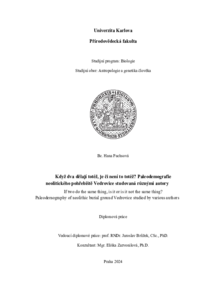Když dva dělají totéž, je či není to totéž ? Paleodemografie neolitického pohřebiště Vedrovice studovaná různými autory
If two do the same thing, is it or is it not the same thing? Paleodemography of neolithic burial ground Vedrovice studied by various authors
diploma thesis (DEFENDED)

View/
Permanent link
http://hdl.handle.net/20.500.11956/193923Identifiers
Study Information System: 238285
Collections
- Kvalifikační práce [20329]
Author
Advisor
Referee
Galeta, Patrik
Faculty / Institute
Faculty of Science
Discipline
Anthropology and Human Genetics
Department
Department of Anthropology and Human Genetics
Date of defense
11. 9. 2024
Publisher
Univerzita Karlova, Přírodovědecká fakultaLanguage
Czech
Grade
Very good
Kosterní soubor z neolitického pohřebiště datovaného do kultury s lineární keramikou ve Vedrovicích (okr. Znojmo) je počtem jedinců v rámci středoevropského neolitu unikátní. Pohřebiště bylo rovněž údajně exkavováno celé, čehož využívá paleodemografie, napomáhající pochopení demografických procesů během neolitizace. Jedinečný soubor 110 koster ze čtyř pohřebních celků byl tak v průběhu let zkoumán více antropologickými týmy používajícími různé metody odhadu věku dožití a pohlaví (Crubézy et al., 1997; Podborský et al., 2002; Dočkalová, 2008; Lillie, 2008). Výsledky jejich analýz se různí, přičemž příčinu lze zřejmě hledat ve využitých metodách, které se liší mírou přesnosti a spolehlivosti. Hlavním cílem této práce bylo porovnat výstupy paleodemografické analýzy vycházející z údajů o věku a pohlaví jedinců z trati "Široká u lesa" čtyř výzkumných týmů. Dále zodpovědět otázku, zda je výpovědní hodnota výsledků čtyř týmů stejná, i když se zaměřily na různé pohřební celky lokality a tím také na rozdílný počet skeletů z lokality, a k hodnocení použily jiné metody? Zároveň bylo výpočtem indexu maskulinity sledováno zastoupení mužů a žen ve vedrovické populaci dle různých týmů a v rámci trati "Široká u lesa". Na základě syntetické tabulky integrující údaje všech týmů byla pro trať "Široká u lesa"...
The skeletal collection from the Neolithic burial site dated to the Linear Pottery culture in Vedrovice (Znojmo district) is unique in the number of individuals within the Central European Neolithic. The burial site was also supposedly excavated in its entirety, which is used by paleodemography to help understand demographic processes during Neolithization. The unique collection of 110 skeletons from the four burial complexes has thus been studied over the years by multiple anthropological teams using different methods of estimating age-at-death and sex (Crubézy et al., 1997; Podborský et al., 2002; Dočkalová, 2008; Lillie, 2008). The results of their analyses are different, and the reason for this can probably be found in the methods used, which differ in their level of accuracy and reliability. The main aim of this thesis was to compare the results of palaeodemographic analysis based on age-at-death and sex data of individuals from the "Široká u lesa" track of four research teams. Furthermore, to answer the question of whether is the predictive value of the results from the four teams the same, even though they focused on various burial complexes of the site and thus different numbers of skeletons from the site and used different methods to assessment? At the same time, the representation of...
